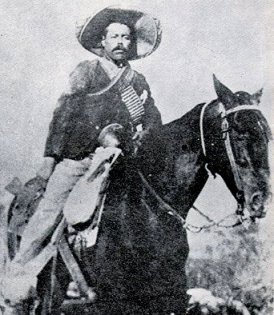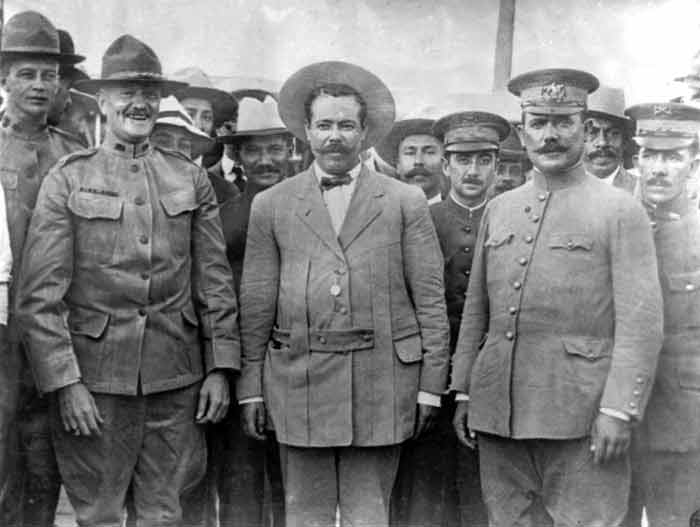Pancho Villa
José Doroteo Arango Arámbula (June 5, 1878 – July 20, 1923) — better known by his nom de guerre Francisco Villa or, in its diminutive form, Pancho Villa — was one of the foremost generals of the Mexican Revolution.
Doroteo Arango was born in San Juan del Río, Durango. His obscure family origins and early life have been confused by the existence of many divergent and poorly documented accounts as well as popular oral tradition. One recent theory (2000) claims he was the illegitimate son of Luis Férman Gurrola, a wealthy hacendado whose own father was an immigrant of Austrian-Jewish origin, and Micaela Arámbula de Arango, a maid.
After working for a time as a peon on his father's hacienda, he left and quickly took up the life of a bandit and outlaw in Durango and later in the state of Chihuahua, whence he immigrated. He was caught several times for crimes ranging from banditry to horse thievery and cattle rustling but, through influential connections, was always able to secure his release.

Villa underwent a transformation after meeting Abraham González, the political representative of Francisco I. Madero in Chihuahua, Chihuahua. González gave Villa a basic education which opened his eyes to the political world and changed the way in which he thought about his own life and his relation to those in power (in the state of Chihuahua, the powerful Creel/Terrazas family). From this point until near the end of his life, Villa considered himself a revolutionary fighting for the people.
In 1911, with U.S. support, Villa helped defeat the federal army of Porfirio Díaz in favour of Francisco I. Madero. Following Madero's power, General Huerta sentenced Villa to death for insubordination. Villa escaped to the U.S. border until it was safe. After that, Villa again rebelled against former allies, first against Victoriano Huerta, later against Venustiano Carranza.

General Pershing(left) with Pancho Villa(center) prior to Villa becoming an enemy of the United States
CREDIT: "Pancho Villa, Alvaro Obregon and John J. Pershing." August 27, 1914. The South Texas Border: The Robert Runyon Photograph Collection, The General Libraries at The University of Texas at Austin.
On March 9, 1916, Villa led 1,500 Mexican raiders in a cross-border attack against Columbus, New Mexico, in response to the U.S. government's official recognition of the Carranza regime. They attacked a US Cavalry detachment, seized 100 horses and mules, burned the town, and killed 17 of its residents. This was the only military attack on or invasion of the continental United States by a foreign state or foreigner in the 20th century.
U.S. President Woodrow Wilson responded by sending 12,000 troops, under Gen. John J. Pershing, into Mexico on March 15 to pursue Villa. In the U.S., this was known as the Pancho Villa Expedition. During the search, the United States launched its first air combat mission when eight aeroplanes lifted off on March 19. The expedition to capture Villa was called off as a failure on January 28, 1917.

Tenth Calvary on the march in Mexico.
In 1920, Villa ended his revolutionary actions. He was assassinated three years later in Parral, Chihuahua. As a perceived rebel against injustice and abuse, and despite the violent excesses he undeniably committed (he was particularly noted for his dislike of people of Chinese extraction and would reputedly massacre any whom he encountered during his raids), Villa is still remembered in Mexico as a folk hero.
Modern historians debate whether Villa was involved with the Germans and how much aid and information passed through them. Some contend that the Germans encouraged Villa's actions against U.S. interests and incursions into Texas and New Mexico in order to create instability on the southern border of a power they definitely did not want interfering in World War I. Other actions by the Germans such as the Zimmermann Telegram correspond with Germany's wish to destabilize the United States. The extent of Villa's role as an abettor of German interests and receiver of German aid is still very much in question, but the idea would not seem to be in contradiction with his opportunistic tendencies.
All text is available under the terms of the GNU Free Documentation License.